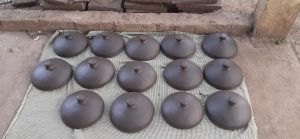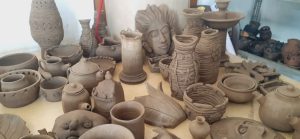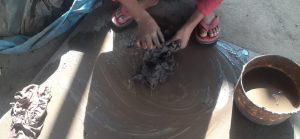Ialam Dhar expeditions into the interiors of Jaintia Hills to discover a craft that has been preserved and thriving through the ages.
 Pottery in India has been traced since ancient times. It was witnessed prior to the era of Indus Valley Civilization. Earthenware is the method of making pots and other crockery items out of clay and other materials where they are heated in a certain temperature to prolong their duration and hardness. Bearing this thought in mind, Sunday Shillong set out on a visit to one of the local potteries in West Jaintia, Tyrshang Lurshai Pottery Co-operative Society, Lumdiengiang established on the 23 March, 2016.
Pottery in India has been traced since ancient times. It was witnessed prior to the era of Indus Valley Civilization. Earthenware is the method of making pots and other crockery items out of clay and other materials where they are heated in a certain temperature to prolong their duration and hardness. Bearing this thought in mind, Sunday Shillong set out on a visit to one of the local potteries in West Jaintia, Tyrshang Lurshai Pottery Co-operative Society, Lumdiengiang established on the 23 March, 2016.
Documenting Lurshai’s journey
 In an interview with a member of the Society, they expressed that the beginning of this art or profession could not exactly be traced as it was practised in times immemorial. This dates back during their forefathers’ life stages and it still exists to this present generation with no sign of declining in the production of earthenware as the demand is relatively stable and probably increasing.
In an interview with a member of the Society, they expressed that the beginning of this art or profession could not exactly be traced as it was practised in times immemorial. This dates back during their forefathers’ life stages and it still exists to this present generation with no sign of declining in the production of earthenware as the demand is relatively stable and probably increasing.
Lurshai Pottery Society, sells their production to local markets and outside Meghalaya with the assistance they receive from Dak_ti Crafts (A craft organisation that presents a unique range of hand crafted products made from natural materials) in Shillong that they are able to expand their merchandise across the state and outside as well.
 Commenting on the nature of work and the immensity of physical labour that goes into this line, especially with the increasing demand of their products, Mething Shylla member of the Society says, “More workforce is required in order to accommodate the production as the demand for such items are increasing day by day.” He also jokes “Pottery is like eggs, one mistake will reduce it all to zero”, drawing attention to the kind of vessels that are extremely fragile and thus need careful handling.
Commenting on the nature of work and the immensity of physical labour that goes into this line, especially with the increasing demand of their products, Mething Shylla member of the Society says, “More workforce is required in order to accommodate the production as the demand for such items are increasing day by day.” He also jokes “Pottery is like eggs, one mistake will reduce it all to zero”, drawing attention to the kind of vessels that are extremely fragile and thus need careful handling.
 Engaging in this type of profession like any other, requires dedication, commitment and persistence as it involves physical brawn. The raw material used (sticky black clay) which is extracted from Sung Valley, costs labour and the loading charge altogether for which a truck of clay’s transportation from the mining area to the workshop also proves expensive. Approximately, it costs a minimum of two lakh along with at least five trucks of firewood that is spent annually for the purpose of heating, as well as enforcing the pottery duration that costs around 80 thousand rupees.
Engaging in this type of profession like any other, requires dedication, commitment and persistence as it involves physical brawn. The raw material used (sticky black clay) which is extracted from Sung Valley, costs labour and the loading charge altogether for which a truck of clay’s transportation from the mining area to the workshop also proves expensive. Approximately, it costs a minimum of two lakh along with at least five trucks of firewood that is spent annually for the purpose of heating, as well as enforcing the pottery duration that costs around 80 thousand rupees.
A typical pottery locally known as ‘Wieñ’ a pot for baking pancake ‘Pu-saiñ’ requires a lot of fine artistry and precision where it takes ten days to its completion- molding, heating and glazing on the whole process.
It was told that students doing their research work used to visit the Pottery Society besides tourists from outside the state even requested to acquire a lesson from this workshop.
Last and not least, the members of the society expressed that grinding and heating machinery are essential in order to quicken the process of flushing out more output from their mini factory. However, they opined that the old technique which was being used here will be preserved as to retain the trail and skill of their forgone forbearers.
Aid and Guidance
In the year 2016, the formation of the Society was facilitated by the the Meghalaya Basin Management Agency (MBMA) through its Enterprise Facilitation Centre (EFC) in Thadlaskein, as part of an endeavour to support local and rural based artisans through capacity building, skill training and development. This was a unique initiative to support networking of technical aspects of marketing and networking with the goal of ultimately promoting and sustaining local artists, and upholding traditional skills.
MBMA supported market and credit linkages after recognizing that these products had every potential to score big in niche international markets. The State’s Planning Department also facilitated the construction of a working shed that has three storage rooms, a workshop, a room for storing the molds, one for the firing process and glazing of the clay pots, and a big-sized oven. So much so that the clientele has extended to metropolitan cities of Delhi and Mumbai and even Internationally in London, Rome and Paris.
On another visit to the Seng Kynthei Pyrtuh Pottery Association which was officially founded in 1983 at Larnai village West Jaintia Hills while interacting with its Secretary Phiiu Pyrtuh relating about different challenges and obstacles they are encountering during these competitive trend where advanced and scientific production of pottery from other states are far more better than theirs of which the output is comparatively large for which they are still using traditional tools and way of moulding the earthenware.
The 15 members of Pottery, which was much earlier than any other workshop in the region, expressed their unhappiness through some assistance from the government but nothing concrete has come through since. While asking them whether any visit or help from their local MLA , they said “No, not a single time giving hints in promoting the fine arts”. With optimism the potters’ societies in Larnai and Tyrshang assure that they will keep and retain this long practiced art to thrive in the next generation in honour of their forefathers fine and work of artistry .
Survival of a craft
In a paper submitted by Dr. Rajesh Bhowmick titled ‘Existence of potteries in North-eastern region of India’ 2020-21, also documents the existence of the art form among the different tribes and regions in NE. It traces the history, the techniques and mechanisms used as well as the kind of products in the form of outputs and substantially finds that in Meghalaya, particularly, pottery was primarily existent in the Jaintia Hills. This is even more evident before the influence of Christianity in the state.
Even though pottery making with hands dates back to the Mesopotamian civilisation in the 4th century BC (modern day Iraq), indigenous tribes and societies of people have often ascribed to an artisanal way of life creating and expressing about their stories. From baskets, pots and other items of earthenware and stoneware, to decorative items such as dolls, fruits and other items of usage- pots, pitchers, glasses, these creations reflect a unique and traditional trajectory of the people of yesteryears.



